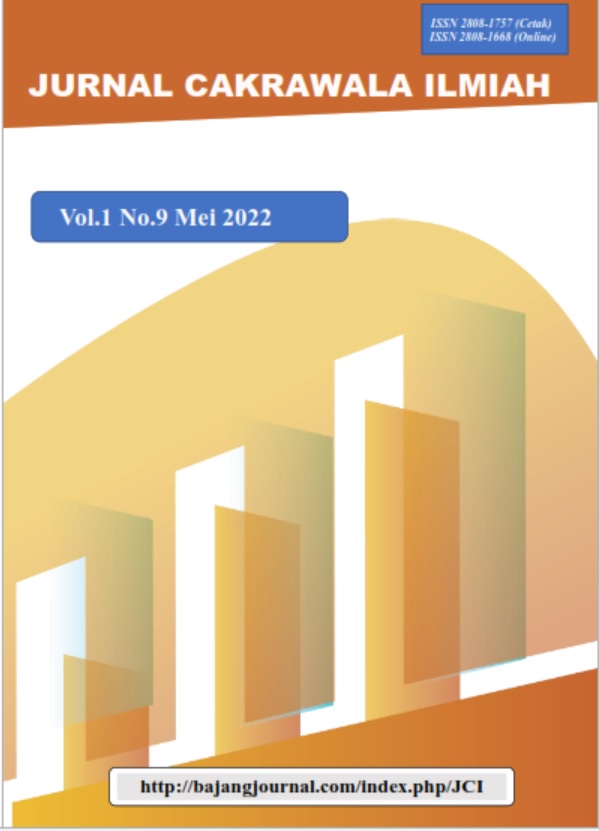Analisa Pengaruh Manajemen Rantai Pasok dalam Meningkatkan Kinerja Perusahaan UNIQLO dengan Menggunakan Sistem Enterprise Resource Planning (ERP)
DOI:
https://doi.org/10.53625/jcijurnalcakrawalailmiah.v1i9.2125Keywords:
Efficient, ERP, Supply Chain Management, Responsive, Competitive StrategiesAbstract
The supply chain is an essential element in a company. UNIQLO as a global clothing company implements ERP-based supply chains. This study aims to analyze the effect of supply chain management in improving UNIQLO performance by using an ERP system. The research method uses qualitative research with data collection techniques in the form of library research. Secondary data are used, namely articles, books, UNIQLO company website, and news. The results showed that UNIQLO supply chain management can affect the financial performance of the company. This is because the more responsive and efficient the supply chain, the better the company's performance is because it can support competitive strategies and vice versa. The competitive strategy determines the UNIQLO company's competitive ability with other companies so having a good competitive strategy will certainly bring greater profits for the company concerned.
References
Abdel-Haq, M. S., Chatti, H., & Asfoura, E. (2018). Investigating the Success and the Advantages of Using ERP System in KSA Context. Engineering, Technology & Applied Science Research, 8(6), 3631–3639. https://doi.org/10.48084/etasr.2367
Anggito, A., & Setiawan, J. (2018). Metodologi Penelitian Kualitatif. CV Jejak (Jejak Publisher). https://books.google.co.id/books?id=59V8DwAAQBAJ&lpg=PP1&dq=Anggito%2C A.%2C %26 Setiawan%2C J. &lr&hl=id&pg=PP1#v=onepage&q=Anggito, A., & Setiawan, J.&f=false
Bantacut, T. (2018). LOGISTIK 4.0 Dalam Manajemen Rantai Pasok Beras Perum BULOG. JURNAL PANGAN, 27(2), 141–154. https://doi.org/10.33964/jp.v27i2.371
Chopra, S., & Meindl, P. (2016). Supply Chain Management Strategy, Planning, and Operation (6th ed.). Pearson Education, Inc. https://www.pearson.com/us/higher-education/program/Chopra-Supply-Chain-Management-Strategy-Planning-and-Operation-6th-Edition/PGM178843.html
Christyono, F. (2017). Analisis Supply Chain Pada PT. Cahaya Indo Persada. Agora, 5(2). https://publication.petra.ac.id/index.php/manajemen-bisnis/article/view/6093
Dwicahyani, A. R., & Rifa, F. A. S. (2021). Review Bidang Kajian Model Persediaan pada Reverse Logistics dan Sistem Rantai Pasok Siklus Tertutup. Jurnal SENOPATI: Sustainability, Ergonomics, Optimization, and Application of Industrial Engineering, 3(1), 46–55. https://doi.org/https://doi.org/10.31284/j.senopati.2021.v3i1.2151
Gattiker, & Goodhue. (2005). What Happens after ERP Implementation: Understanding the Impact of Interdependence and Differentiation on Plant-Level Outcomes. MIS Quarterly, 29(3), 559. https://doi.org/10.2307/25148695
Hasibuan, A., Banjarnahor, A. R., Sahir, S. H., Cahya, H. N., Nur, N. K., Purba, B., Arfandi, S. N., Prasetio, A., Ardiana, D. P. Y., & Purba, S. (2021). Manajemen Logistik dan Supply Chain Management. Yayasan Kita Menulis. https://books.google.co.id/books?id=OVojEAAAQBAJ&lpg=PA11&ots=CKWbwIZKX4&lr&pg=PA11#v=onepage&q&f=false
Hayati, E. N. (2014). Supply Chain Management (SCM) dan Logistic Management. Jurnal Ilmiah Dinamika Teknik. https://www.unisbank.ac.id/ojs/index.php/ft1/article/view/3039
Hugos, M. (2011). Essentials of Supply Chain Management (J. Wiley & Sons (Eds.)). Wiley. https://doi.org/10.1002/9781118386408
Menon, S. A., Muchnick, M., Butler, C., & Pizur, T. (2019). Critical Challenges in Enterprise Resource Planning (ERP) Implementation. International Journal of Business and Management, 14(7), 54. https://doi.org/10.5539/ijbm.v14n7p54
Puspitaningrum, A. C., & Sintiya, E. S. (2018). Literatur Review : Critical Success Factor Penerapan Sistem ERP pada Perusahaan Manufaktur di Negara Berkembang dan Maju. Jurnal Nasional Teknologi Dan Sistem Informasi, 4(2), 89–97. https://doi.org/10.25077/TEKNOSI.v4i2.2018.89-97
Rani, M. S., & Rani, M. M. (2019). Sustainable Development: Future Genration’s Needs. International Journal of Research in Economics and Social Sciences (IJRESS), 8(4). https://euroasiapub.org/sustainable-development-future-genrations-needs/
Rustyani, S., & Rosyidi, S. (2020). Measurement of Efficiency and Productivity of Amil Zakat Institutions in Indonesia by using Data Envelopement Analysis Methods and Malmquist Productivity Index. Jurnal Ekonomi Syariah Teori Dan Terapan, 6(2), 270. https://doi.org/10.20473/vol6iss20192pp270-287
School, M. B. (2018). Differential Pricing. Monash University. https://www.monash.edu/business/marketing/marketing-dictionary/d/differential-pricing
Taghipour, M., Shabrang, M., Habibi, M. H., & Shamami, N. (2020). Assessment and Analysis of Risk Associated with the Implementation of Enterprise Resource Planning (ERP) Project Using FMEA Technique (Including Case-Study). Management, 3(1), 29–46. https://doi.org/https://doi.org/10.31058/j.mana.2020.32002
Uddin, M. A., Alam, M. S., Mamun, A. Al, Khan, T.-U.-Z., & Akter, A. (2019). A Study of the Adoption and Implementation of Enterprise Resource Planning (ERP): Identification of Moderators and Mediator. Journal of Open Innovation: Technology, Market, and Complexity, 6(1), 2. https://doi.org/10.3390/joitmc6010002
Widayanto, Y. (2013). Model Perumusan Kebijakan Pendukung Pengembangan Industri Kakao Berbasis Kinerja Driver Rantai Pasok. Institut Pertanian Bogor. https://digilib.bppt.go.id/opac/index.php?act=notice_id&id=330171
















